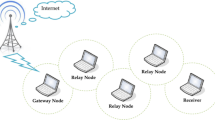Abstract
A star-like regional wireless network under the IEEE 802.11 protocol is studied: its end stations are hidden from each other and linked only with the base station—the point of access to outer networks. It provides access to the Internet to users of cable LANs connected to its end stations. Transfer of large files through TCP/IP connections forms the main bulk of the wireless traffic. Methods for estimating the maximal network throughput for transmission of TCP-level information are designed.
Similar content being viewed by others
REFERENCES
Wireless LAN Medium Access Control (MAC) and Physical Layer (PHY) Specifications. ANSI/IEEE Standard 802.11, 1999 Edition.
Vishnevskii, V.M., Teoreticheskie osnovy proektirovaniya komp'yuternykh setei (Theoretical Principles of Computer Network Design), Moscow: Tekhnosfera, 2003.
Vishnevskii, V.M., Lyakhov, A.I., Tereshenko, B.N., et al., Regional Wireless Data Transmission Networks based on Radio-Ethernet Protocol: The State-of-the-Art, Modeling, and Realization, Inform. Protsessy, 2001, vol. 1, no. 1, pp. 10–32.
Bianchi, G., Performance Analysis of the IEEE 802.11 Distributed Coordination Function, IEEE J. Selected Areas Commun., 2000, vol. 18, pp. 535–548.
Cali, F., Conti, M., and Gregory, E., Dynamic Tuning of the IEEE 802.11 Protocol to Achieve a Theoretical Throughput Limit, IEEE/ACM Trans. Networking, 2000, vol. 8, pp. 785–799.
Vishnevsky, V.M. and Lyakhov, A.I., IEEE 802.11 Wireless LAN: Saturation Throughput Analysis with Seizing Effect Consideration, Cluster Comput., 2002, no. 5, pp. 133–144.
Vishnevsky, V.M. and Lyakhov, A.I., Estimation of the Throughput of a Local Wireless Network under High Traffic and Disturbances, Avtom. Telemekh., 2001, no. 8, pp. 81–96.
Vishnevsky, V.M. and Lyakhov, A.I., 802.11 LANs: Saturation Throughput in the Presence of Noise, Proc. 2nd Int. IFIP TC6 Networking Conf., Pisa, Italy, 2002; Lect. Notes Comput. Sci., 2002, vol. 2345, pp. 1008–1019.
Lyakhov, A.I., Matsnev, D.N., Lakontsev, D.V., and Shelikhov, O.N., Collection and Analysis of Operation Characteristics of the Existing Wireless Networks under the IEEE 802.11 Protocol, VIII Mezhdunar. konf. po inform. setyam, sistemam i tekhologiyam (VIII Int. Conf. on Inf. Networks, Systems and Technol.), St. Petersburg, 2002, pp. 225–235.
Schriber, T.J., Simulation using GPSS, New York: Wiley, 1974.
Higher-speed Physical Layer Extension in the 2. 4 GHz Band. IEEE Standard 802.11b-1999, 2000 Edition (Supplement to [1]).
Semenov, Yu.A., Protokoly i resursy Internet (Internet Protocols and Resources), Moscow: Radio i Svyaz', 1996.
Author information
Authors and Affiliations
Rights and permissions
About this article
Cite this article
Vishnevskii, V.M., Guzakov, N.N. & Lyakhov, A.I. Maximal Throughput of Wireless Access to the Internet: Its Estimation. Automation and Remote Control 65, 1400–1416 (2004). https://doi.org/10.1023/B:AURC.0000041419.24846.7e
Issue Date:
DOI: https://doi.org/10.1023/B:AURC.0000041419.24846.7e




